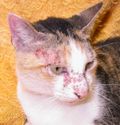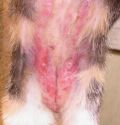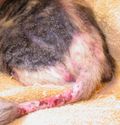 This is "Patches", a 3-years old kitty who is a total house-cat, unless she
This is "Patches", a 3-years old kitty who is a total house-cat, unless she
escapes (which happens rarely).
Three weeks ago, the owners had
some kitchen vent-hood problems. An opening was created, allowing the
cat access (via a series of jumps) to the attic crawlspace. The space
is unfinished, with exposed joists and fiberglass bat insulation
between the ceiling joists.
When recovered from the attic, she
became intensely itchy, excoriating herself and losing hair. Over a
couple of weeks, she recovered about 90% and was doing much better. Five days ago she gained
access to the attic again. The itching exploded. She has some mild spots of hair loss and scabbing (from self-trauma) on top of her neck and rump, also the lower hind legs. Those areas are
similar to the facial area in the picture.
 Take a look at her belly, though. If that doesn't make you hurt, you just have no empathy at all. Her tail is even worse. She's been biting holes in it.
Take a look at her belly, though. If that doesn't make you hurt, you just have no empathy at all. Her tail is even worse. She's been biting holes in it.
 I believe that fiberglass is the likely
I believe that fiberglass is the likely
culprit. I know that I get really itchy if I just handle the stuff a little bit. In searching Veterinary Information Network, I could only find a few cases mentioned. They suggested that you might be able to find the glass fibers by doing a skin scraping (like you would for mange mites) or by using clear tape to lift little thingies from the skin. I tried a skin scraping and found nothing. A scotch-tape
preparation yielded some debris that might be fiberglass and might be
anything, really.
 I went up to the clinic attic and gathered the
I went up to the clinic attic and gathered the
little glob of fiberglass in the picture. My fingers itched for an hour afterward. I cut off a little to look at under the microscope. My eyepiece cam is
low resolution, so this won't show up well. The heavy dark line at lower left is one of my own human hairs.
The salient information is
that the fibers were of dramatically different shapes and sizes. Some
looked straight and stiff, others coiled up. Some were three times as
thick as others. Some had little globules, like nits, along their
length, others did not.
In short, you could take virtually any linear
debris from the cat's skin and find a fiberglass fiber that resembled
it. So did I get fiberglass from the cat? Is fiberglass the problem?
One of the dermatologists I consulted with says that her own cat gets in the attic and plays with the insulation and has no problems at all. On the other hand, there were other case reports of fiberglass-associated dermatitis available… and my own hand itching for an hour after barely touching the stuff.
 Treatment-wise, the only suggestions I found in my research were topical cortisone and tincture of time (three weeks to grow a new layer
Treatment-wise, the only suggestions I found in my research were topical cortisone and tincture of time (three weeks to grow a new layer
of skin?). I gave her a little dexamethasone injection and sent home DermaCool
HC for topical use several times daily. She is to come in for a recheck after two days. I may have to bandage
the tail, get an e-collar and add antibiotics. I've sure got to do something. She looks tough.


What do you do for a german shephard with Fiberglass Dermatitis?
Does (or did, given the how long ago this was posted) your neighbor’s cat have longer fur? I’m in East Oregon and have been looking after a stray with long fur. It’s been snowing the past week and the cat has been showing up with bits of insulation in its fur. So apparently it finds some kind of shelter when I’m at work…I’m just hoping the insulation isn’t too harmful because this cat will not tolerate grooming, and I’ve tried it with metalworking gloves and puncture sleeves…
Hello, Gerald,
The cat had your basic domestic short-hair (aka “alley cat”)short cat hair.
It’s direct contact with skin and fibers that causes the irritation. They are prickly.
They’ll fester out eventually. If the cat isn’t traumatizing itself, I wouldn’t expect any problems.
I have a collie that go in contact with insulation and just layed in it. He started itching and also pulling his hair out and biting himself. We took him to the vet and he gave him a steroid injection. It seemed to help but it is worse now. What can I do at home to make him better. He is a yard dog & doesn’t come in the house at all.
Hello, Ruth,
If you haven’t already given him a good bath, you should do that.
Benadryl may help a little, sometimes it just makes them too sleepy to scratch, but at least the dog gets some rest. Check with your veterinarian for an appropriate dose.
It will take some time for the fibers to work their way out. I don’t know anything else to do right now.
I adopted a 14 year old rescue jack Russell who had been kept as an outdoor dog. The owners provided her with a fiberglass insulation lined doghouse. She has large patches of tough darkened skin. Red and black belly. The edges of her ears are black and crunchy. She does have other issues that could contribute to her skin but I’m convinced the years of fiberglass are the primary culprit. I have a specialty shampoo and we’ve gotten her a cytopoint shot but haven’t seen much relief. Any suggestions for giving this old lady some relief that she deserves?
Get rid of the dog house.
Hello, TK,
Black crunch ears sounds like a vasculitis problem – inflammation of the small blood vessels. I would recommend a biopsy of the affected areas. The fiberglass might be part of the problem, but usually you have to have direct skin contact with it, and I don’t think the edges of the ears would be getting much contact.
I have a Rescue, and saved a mom and her one-week-old (short-hair) pups from insulation under an abandoned trailer. We have bathed them in Dawn and Selsum Blue, but these babies are scratching themselves raw and almost hairless. What else can we do? I cry with them. 🙁
Hello, Tammy,
Dawn is great for grease, but in a non-greasy dog it can really dry their skin. This would not help with the irritation from the insulation. I would be looking at moisturizers and soothing type shampoos, like an oatmeal bath. There is medicated shampoo called Relief shampoo (and they make a topical spray) that has the oatmeal and a topical anesthetic. If you can’t get that, the regular Aveeno bath is not bad.
Do Not use dawn. Use an oatmeal based shampoo.